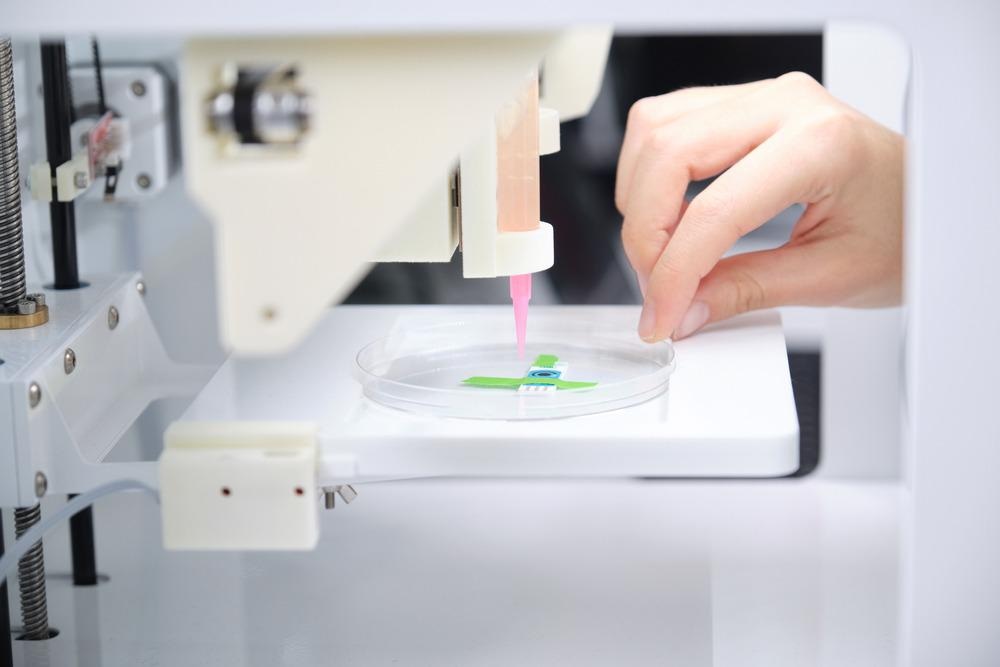Scientists from the People’s Republic of China have evaluated the importance of electrostatic interactions to improve the bioprinting of constructs with sodium alginate-based bioinks by incorporating biocompatible additives. Their work has appeared in the journal Bioprinting.

Study: Harnessing electrostatic interactions for enhanced printability of alginate-based bioinks. Image Credit: Ladanifer/Shutterstock.com
3D Bioprinting: A Promising Technology
In recent years, the field of tissue engineering has received intense research focus due to its potential for repairing damaged and diseased tissues and organs. Amongst the technological advances that have made this field possible, 3D bioprinting has played a significant role recently. This technology is highly advantageous due to its ability to meet the individual needs of clinicians and patients.
Despite its promising potential, there are still challenges with 3D bioprinting that hinders its widespread clinical application. Bioinks have difficulty satisfying both printability requirements and material properties. Improving the design of bioinks to meet printability requirements is essential for obtaining constructs with the properties required for tissue engineering applications.
It is, therefore, crucial to evaluate bioink performance at both the micro and macro scales. High-performance bioinks provide superior shape fidelity but negatively impact the bioactivity of cells. Conversely, bioinks with poor mechanical properties enhance cell survival and proliferation in the tissue engineering microenvironment but may not meet the shape fidelity requirements of high-precision tissue engineering applications.
Developing bioinks that meet the requirements of both structural fidelity and ensuring the growth, proliferation, and survival of cells is a key area of research in 3D bioprinting and tissue engineering.
Sodium Alginate Bioinks
Amongst the various bioinks that have been evaluated for use in 3D bioprinting, sodium alginate has become one of the most common hydrogel bioinks used. This bioink possesses several benefits, including low cost, high biocompatibility, the ability to mimic the extracellular matrix, and the ability to create a 3D “egg-box” shaped architecture with the incorporation of crosslinking agents.
Despite its benefits, sodium alginate bioink possesses some critical drawbacks. At low concentrations, the bioink’s mechanical properties are insufficient for 3D tissue engineering applications. Research has focused recently on the use of natural and synthetic additives and ionic crosslinking agents to improve the material’s mechanical properties and stability.
Alginate bioinks can be modified by many biocompatible materials, though the effect of these additives on the printability of bioinks has been rarely reported. Two such biocompatible materials that can improve the mechanical properties and stability of alginate bioinks are chitosan and laponite. Research has revealed the role of electrostatic interactions in improving the mechanical properties of bioinks.
Ideal bioinks must possess several properties, including biocompatibility, printability, degradation, and mechanical stability. In recent years, significant attention has been placed on evaluation methods and determining printing parameters. Several methods have been developed to evaluate and characterize bioink printability.
The Study
The current work has presented a methodology that combines several previously established evaluation methods. Thorough examinations of the influence of additives and the effect of electrostatic interactions on the printability of alginate bioinks have been conducted by the authors.
In the study, chitosan and laponite-modified sodium alginate bioinks were prepared with different concentrations. The influence of different concentrations of laponite and chitosan on the mechanical properties and printability of alginate bioink constructs was evaluated. Additionally, the subsequent physiochemical and biological properties of the materials were thoroughly analyzed.
A systematic printability method was applied to evaluate the changes in the bioinks caused by electrostatic interactions. One layer, two-layer, and multi-layer models were employed in the research. The aim of the research was to fabricate sodium alginate bioink-based scaffolds which possess high shape fidelity and printing precision.
Study Results
In comparison to unmodified bioinks, chitosan and laponite-modified sodium alginate displayed enhanced shape fidelity. This was due to the electrostatic interactions of the incorporated biocompatible additives.
In the one-layer models, filaments underwent reduced collapse and fusion. The Pr values of two-layer constructs were close to their ideal number. Multi-layered structures produced with the modified bioinks also underwent less collapse. Additionally, multi-layered constructs possess thinner walls compared to unmodified sodium alginate bioink-produced structures.
The compressive moduli of the laponite and chitosan-modified bioink structures were also superior to that of the constructs printed with unmodified sodium alginate bioink. Furthermore, the swelling ratio was decreased, meaning that printed structures can more closely adhere to their desired shapes.
Excellent biocompatibility was revealed by cell adhesion and proliferation experiments, with chitosan-modified bioinks possessing similar proliferation capabilities to unmodified alginate inks.
In summary, the study highlights the influence of electrostatic interactions on bioinks. Harnessing these interactions produces materials with suitable printability, mechanical properties, and biocompatibility and can be considered for tissue engineering applications.
More from AZoM: How are PAT Techniques Used for Real-Time Particle Analysis?
Further Reading
Bai, J et al. (2022) Harnessing electrostatic interactions for enhanced printability of alginate-based bioinks Bioprinting e00215 [online, pre-proof] sciencedirect.com. Available at: https://www.sciencedirect.com/science/article/pii/S2405886622000252?via%3Dihub
Disclaimer: The views expressed here are those of the author expressed in their private capacity and do not necessarily represent the views of AZoM.com Limited T/A AZoNetwork the owner and operator of this website. This disclaimer forms part of the Terms and conditions of use of this website.